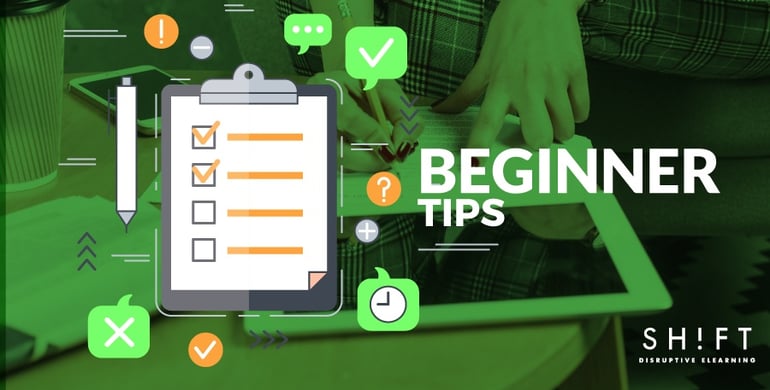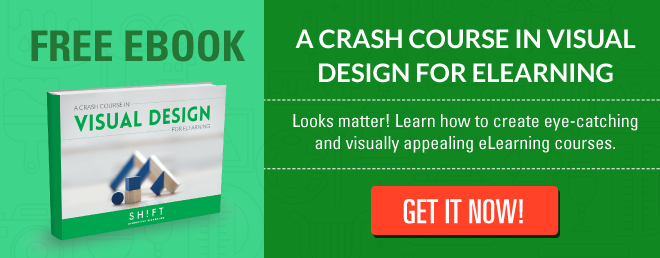Though building an eLearning course isn’t necessarily an easy task the first time around, it doesn’t have to be a frustrating experience. Like most things in life, creating your first course simply requires structure and a little know-how.
If you’re here, you are probably a beginner and eager to learn more about how to create effective eLearning courses. In an attempt to make your journey easier, we’ve compiled five essential tips to help diffuse the drama around successful eLearning development.

1) Don't Skip The Key First Step: Define The Purpose and Objectives
To begin an eLearning course successfully, you have to consider why exactly are you starting it. Is there a problem that needs to be solved? Why do employees need this program? And what are the desired outcomes for the company and learners?
Knowing what a client or student should know by the end of the course will define what you decide to include, how it is introduced, and when to introduce it. When learning objectives aren’t clearly defined, the timing and effectiveness of elements that are included in the program will most likely reflect a similar vagueness.
For those who struggle with defining objectives--and even for those who don’t, Bloom’s Taxonomy is a great resource. This is a classification of the different learning objectives and skills that you set for your students (learning objectives). Learn more here.
Another practice that you might find helpful is content mapping. The art of content mapping is based on identifying the behaviors that you’re trying to change, matching the action with one or more learning objectives that fit. It’s imperative that you don’t just dive in. A little purpose can help your content flow smoothly from one source to another. The last thing you want a user to feel is doubtful.
Once again, defining goals will lead to selecting the appropriate instructional design techniques.
Read more: Write Rockin’ Course Objectives: 7 Do’s and Don’ts
2) Define Your Target Audience and Get to Know Them Well!
A big part of the “why” is about your audience and their needs. To understand them better, you need to take a close look at their skill gaps, their goals, motivations, where they are, and where they need to be.
Think about it. How will you know what level of content is applicable for your users? Are you developing a module for executives, for people who have two years of experience, or people who have over 30 years in the field?
An often-neglected part of audience analysis is understanding what they expect. What do your learners expect to gain from the course? If you don’t bother to learn this, you may find a group of disappointed and disillusioned learners who are unable to engage with the material.
When you understand your audience, you’ll be able to properly base your first eLearning course on:
- Existing needs within the organization
- Addressing a skill gap or other problem
- Goals, and benefits to learners
Basing your course on these things is far more beneficial than creating learning for the sake of learning.
Helpful resources:
- These 27 Questions Will Help You (Really) Know Your Learners
- The 5 Best Ways to Research Your eLearning Course Target Audience
- A Template to Carry Out an eLearning Audience Analysis
3) Don't Just Transfer Instructor-Led Training to E-learning
Don’t fall into the trap of thinking, “I already have a successful classroom training program. I just need to transfer this online, and I’m all set.”
More often than not, the initial attempt at online learning is based entirely on PowerPoint-based training or a simple text document. Transferring content from any of these formats to an online platform is an art as the delivery changes completely.
What may work great in traditional classroom settings may ultimately fail in eLearning environments. A lecturer can stop and talk through a PowerPoint presentation to an in-person audience — but online or on mobile devices, this content will likely lose the audience quickly.
Instead of simply transferring content, consider how you will instead transform it to best serve the needs of your online learners.
Here are a few points to consider to help content stay as effective as it was in its original form:
- Interactive Elements: Whether it’s video, audio, or interactive features further addressing a point can keep content engaging. Since we no longer have the interaction in the classroom, these elements help bring the content to life
- Characters: These can interact with students throughout your course. Also, they can also be leveraged to determine comprehension of the material.
- Assessments: Adding assessments throughout the course will be helpful in testing the student’s knowledge and give them a sense of achievement as they continue to complete milestones on their journey.
Transferring content to an online platform is a great exercise for any instructor or organization to brush up on what’s really essential and how it can best be communicated to anyone who is in need of the skills being shared.
Go over these helpful resources:
- Guide to Converting Classroom Training To eLearning
- Moving Your Existing Training Content to eLearning - A Step-by-step Guide to Successful Conversions
4) Shift Focus from Content to Learner Experience
Despite subject matters being objective, the act of learning tends to be an emotional adventure. This is why you want to make sure that you make this experience a pleasant one. An example of this is shying away from verbose content or complex words. Reading for long periods or having to look up words may discourage the student in this particular environment. That’s why it’s important to cater to the learner’s preferences when creating your course.
What does this mean?
- First off, you’re going to want to take the time to make sure that your course isn’t a creative mess. Yes, be creative, but don’t be all over the place. Stick to a few sets of fonts in the same places. Keep things clear and purposeful. Most learners will be anxious to get started so make sure that your content doesn’t discourage or overwhelm them. Prepare them and then, send them off.
- Use links or sources on your screen that allow your audience to additional information quickly. This will make your course look straightforward and less crowded. Also, if learners want to know more, you’ve provided them with the resources to download the extra material.
- Adopt the less-is-more approach for onscreen text. With so many elements vying for the learner’s attention on a cluttered screen, they are compelled to split their attention between reading, absorbing, and analyzing the information. Learners become confused and cannot fathom what to focus on. The human brain cannot function optimally if it is made to multi-task. It’s difficult for the eyes to find the focal point and grasp the most important information.
- User-friendliness is a priority. Making sure it’s easy to use, easy to navigate, and pleasing to look at will create an immediate fondness for your course. Shy away from artsy fonts. Before publishing it, make sure navigation is intuitive, colors and layouts are not distracting, and progress can be followed with ease.
Also read: Four Key Elements of Learning Experience Design
5) Quality Assurance
One of the final steps in any work is assuring the quality of the end product. It’s important to make sure that content and visuals flow properly. By checking all of your content, you’ll avoid having a learner unable to move forward because a section or link isn’t working properly. The smoother their experience goes, the more credible your course and each of the elements that you’ve provided for them will be.
A good checklist to swear by:
- No grammatical errors, typos, misspellings, or vague sentences
- Avoid verbose explanations and confusing visuals
- Referencing content properly
- Checking facts, stats, and data, and that links work properly
Check for consistency too: The consistency of a course reduces the cognitive load of learners focusing on unnecessary features of the course. If every screen of the course has different color schemas and fonts, it does not foster a continuous learning experience. A consistent tone is also important so that users don’t feel the program was written by various people.
The last thing you want is someone doubting what they are learning. Once doubt is introduced, your learners won’t be as receptive. As they say, content is king.
So as we mentioned earlier, creating an eLearning course doesn’t have to be a frustrating experience. Use these tips as a guide to help share your knowledge effectively. The world is waiting!
Here are some other beginner resources you might want to check out later:


